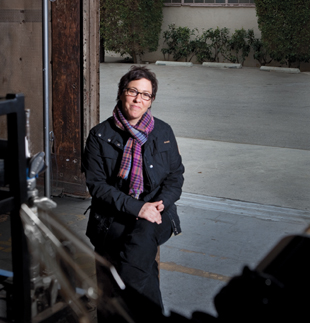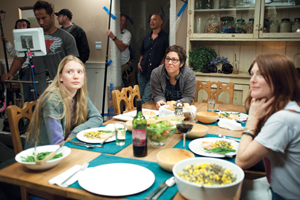BY AMY DAWES
 NEW RULES: Cholodenko says working on The Kids Are All Right was a
NEW RULES: Cholodenko says working on The Kids Are All Right was a
huge learning curve for her. She realized "I could jump time or get
broad without being banal. It was liberating." (Photo: Brian Davis)There was a moment during postproduction on The Kids Are All Right that, as Lisa Cholodenko tells it, may have made a critical difference in turning her third feature into the career breakthrough it is poised to be.
"When we put it together, Jeff Werner, the editor, and I were very much in the same head. We were being really careful and dutiful to the moments in the performance, fleshing things out in their most deep and grounded way, so for a long time, the film had a kind of languorous pacing," Cholodenko recalls.
At that point, she was about 10 weeks into postproduction and the producers were knocking on the door. "I got concerned. I thought, I can't get away from my own goddamn style, even though it's written differently and shot differently."
That languor had been an asset in her 1998 debut High Art, an edgy independent feature set among heroin users in the downtown New York art scene, but on Kids, she had set out to craft a decidedly more commercial movie.
So less than two months before its world premiere at Sundance this past January, she screened the work-in-progress for her collaborators, including Cinetic Media's Bart Walker, whose company had arranged the film's financing.
"He said, 'You've got a really great film here, but you need to go back into the cutting room and make it pop. End where you don't want to end. Get onto the next thing.'"
Cholodenko saw it as a turning point. "I thought, this is a real learning curve for me. If I can give the film this kind of energy, this kind of pace, that's what's going to make it work. And I just got ruthless on it."
With her editing team, she cut nearly 15 minutes from the film, which stars Annette Bening and Julianne Moore as lesbian parents whose family bonds are tested when their two teenagers seek out their sperm donor father (Mark Ruffalo). To her surprise, Cholodenko found the exercise exhilarating.
"It was an opportunity to put on a hat I don't typically wear," she muses. "The hat of the person who's not afraid of making bold choices. Or trying stuff. Or being brave."
It's an odd confession, coming from a filmmaker whose choice of material has been nothing if not bold. High Art, which she wrote as a graduate film student at Columbia in the mid-'90s, focused on an ambitious young magazine staffer (Radha Mitchell) who leaves her boyfriend to enter an intimate relationship with a celebrated lesbian photographer (Ally Sheedy). Laurel Canyon (2002) centered on an L.A. record producer (Frances McDormand) and her younger boyfriend (Alessandro Nivola), whose free-spirited, creative lifestyle proves seductive to her son's young girlfriend (Kate Beckinsale), leading them to skirt the edges of a ménage à trois.
 DINNER TIME: Cholodenko (center) set the table for a provocative
DINNER TIME: Cholodenko (center) set the table for a provocative
domestic situation in Kids, with Mia Wasikowska (left) and
Julianne Moore. (Credit: Suzenne Tenner/Focus Features)Both films landed slots in the Directors' Fortnight at Cannes and received critical praise, though box-office returns were modest. Still, Cholodenko had laid an auspicious foundation for a career, but the resulting options created conflicting desires that contributed, she admits, to the eight years that have slipped away since her last feature.
To help pay the rent, she had gotten a foothold in TV, directing episodes of Six Feet Under, Homicide and The L Word. "I was really green, and I didn't know how to function in that world," she recalls. "I wasn't fast, and I wasn't prepared, and I didn't know that those were the highest values in that environment." The experience made her appreciate the creative freedom one has in making features, though that brings its own dilemmas.
"It's not as if I consciously said, 'Yeah, man, I'm going to stay on the edge of the industry and do it my way,'" she says. "Scripts were sent to me and I went on a lot of meetings. I had things in development. But the deeper I got into the projects that were being offered to me, the more disenchanted I got. I wanted everything I did to have the potential to be really affecting. And I couldn't get out of that mindset.
"And as it turns out, if you're not productive for a number of years, there are other people who are, so you get shunted to the side. To think I had potentially fumbled the ball by not acting aggressively enough, or by being too high-minded, I felt very worried."
Meanwhile, Cholodenko's partner was enjoying success and urged her to set aside financial concerns and distractions to focus on creating something personal. "It was both a blessing and a curse. Because I'm thinking, now I have to fucking do it."
While working in a coffee shop on the initial pages of Kids, she ran into a screenwriter friend, Stuart Blumberg. "He suggested that I needed to flip my work into a more commercial sensibility. They decided to work together and the collaboration became the key to Cholodenko's dawning realization that as a filmmaker, she might be able to stay true to seemingly radical and personal stories, and still appeal to a wider audience.
"It was a great education," says Cholodenko. "Seeing that I could express things another way, that I could jump time, or get broad without being banal. It was liberating."
When she made High Art, she said in an interview at the time that her tendency was to go for the understated or the subtle, maybe too much. "I was directing my first feature, my first love scene. At one point, the cinematographer said, 'Look you guys, I think we're being a little conservative with this. We just got to push it a little further.'"
So amping up the humor was part of her new visual strategy for Kids. "I wanted the comedy in this to be more overt, more robust, and I generally let things play wider. For example, there's a sex scene shot from the middle of the room as almost one long single take. From that distance you capture more body language and comedic energy."
This approach also proved practical. With a $4 million budget and a 23-day shoot on locations in Echo Park, Venice and Mar Vista, Kids didn't allow for many setups. By contrast, Laurel Canyon had twice the budget and a 33-day shooting schedule.
Casting correctly, she says, was vital. "I hired people who I thought could absolutely pull it off without a lot of preparation," says the filmmaker, who did a week of rehearsal on essential scenes with Bening and Moore. "But there's still a lot of tension going into it, because you don't have any extra chances. You don't get the luxury of exploring things, or tweaking in ways that could make something better or more beautiful or more elegant."
On scenes with the trickiest emo-tional dynamics, Cholodenko says her approach was simply to stand by as a psychic presence and guide. "I find that the less analytical one can be, the better, because it starts to create anxiety," she says. "With actors at that level, you let them know that you're watching, and you'll tweak them this way and that if you need to, but you're mainly going to give them space."
Casting is also an important aspect of offsetting financial risk for the kind of edgy material she has chosen to do. "With Kids, I wanted to tackle this antiquated idea that gay people can't raise children who are normal and balanced," she explains. "But it could easily have been perceived as very marginal, very art house. I had to figure out how to make this film work in a commercial way with an independent spirit, and with actresses who aren't ingénues anymore, but are really sexy and vital and bankable."
When it comes to directing her camera crew, Cholodenko prefers to work from a shot list and sketches rather than storyboards. She and her DP, Igor Jadue-Lillo, sat down for weeks and went through the script scene by scene, discussing how they were going to shoot it and with what stock and lenses. "I regret that I don't know more about the hard science of lighting and film stock and ratios, but my eye is my guide," Cholodenko admits. So in hiring a DP, "I have to see something in that person's work that moves me, and we talk about how they see this film, and what our common reference points are. These shoots are kind of brutal, and they're fast and underpaid, so I find that it has to be a passion project for somebody." Especially for herself.
As she sees it, the time she's taken with her career and the hard choices she's made might just be paying off. "I feel like I'm finally in a position to have better things offered to me that I don't necessarily have to originate," she says. "I love all kinds of genres, but there has to be a level of sophistication and competence. I've spent a lot of time trying to make movies that have integrity, so now I hope I can have access to material that's fresh and interesting."